Previous Page | Right click this page to print.
Needs of Dogs and Cats and Photos
Some factors we need to think about for determining energy needs of dogs and cats. Obviously, their body weight is really important. Their size, actual height and length is really important. And their activity level is very, very important. Those are the three factors that are really important for determining how we’re going to determine energy levels for these animals. Here we have a picture of a Wolfhound.
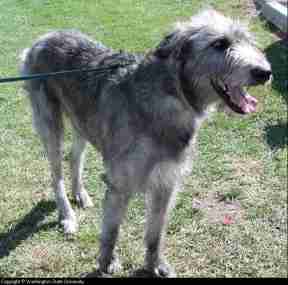
Do you know how big they can get? Huge. This guy here is about 80 lbs, he’s probably 27 inches at the shoulder and one of these Wolfhounds will make him look small. Very, very big dogs. We get at almost 200 lbs with them.
Great Danes, Mastiff, these are very big dogs.
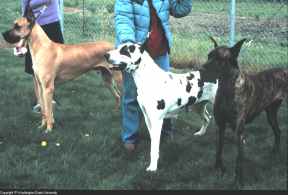

Now, that is not a big dog. Chihuahua, Dachshund, these are small dogs.


Okay. But dogs nonetheless. We have this huge disparity in size between the big dogs and the little dogs.
And then we have to factor in that we have working dogs.
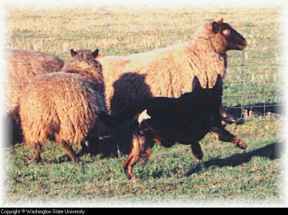
They’re going to take more energy than some that are not working.
If they’re playing, they can have a really good time.
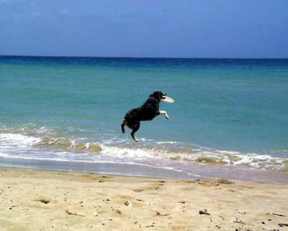
And you’ve got exercise that goes on with your dogs.
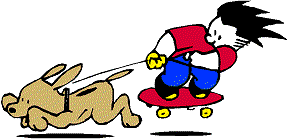
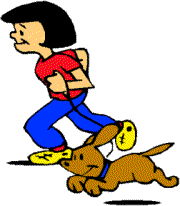
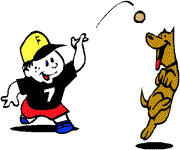
Things that we do together. It’s going to take energy.
And of course, there’s the dog that isn’t really doing too much at all.
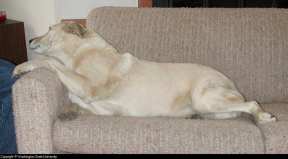
His energy needs aren’t going to be quite as high as one would expect from somebody that’s working.
A principal of energy use for, you know, endothermic animals, for warm blooded animals: as the body weight increases, the actual energy need per unit weight decreases because they can actually spread it out through a bigger body mass. They probably do eat more total volume of things, but their energy needs are actually smaller compared to a small animal. What we’re concerned about is the total surface area of the animal. What you do is take your body weight and you actually take it to an exponent, anywhere from 0.67 to 0.75. These are studies that have been done for, probably for a long time, trying to determine how an animal's energy is related, energy requirements are related to their body size. And these are the kinds of things they have come up with to give us some handle on what their actual energy requirements are. We’ve talked about the endothermic animals, etc… and their body needs. And so what that’s called is a metabolic body weight. One of the ways we find that is by multiplying by this, one of these two exponents here, either 0.67 or 0.75. The one that we generally use for dogs is 0.67. Some of this information may change in the near future here because they’re actually coming out with a new NRC requirements for cats and dogs. It’s going to be coming out, probably the summer here, 2003. If you’re actually very interested in this, in cat and dog nutrition, it’ll be coming out and it should be very interesting to see what they’ve done, especially with the energy requirements.
If I want to find out the energy requirement for say a 77 lb dog, what I need to do first is divide by 2.2 because we need to do this in kilograms, that’s weight in kilograms there. Comes out to 35 kg. If I put it to this 0.67 exponent, that actually equals 10.83. That’s just a number, so far. What I need to do to find the whole requirement is I need to calculate this times a constant that is related to activity levels. Remember, we looked at is your dog laying on the couch all day long or is he out herding sheep? There’s a difference in activity levels there. And so that has to be taken into account. These are numbers that I didn’t come up with, you know people who are in the field have come up with. A number for a fairly laid-back dog, like we have right here with Comet, an older dog probably, is a constant number of 132. If we take that 132 and we multiply it by the 10.83, what you come up with is 14, we’ll round up to 30 kilocalories of ME (1,430 kilocalories of ME). What I’ve done here is found that I have a dog, a fairly low activity level, at a body weight of 77 lbs which I converted to kilograms. I could estimate, now remember this is an estimate, but it gives you an idea of where you’re headed. This is his energy requirement. It's what he needs in a day, his daily requirement. That’s the amount of calories he needs to maintain his body functions, to do his activities, to do the things he needs to do. You can apply the same thing to cats, if you’re interested in that. Cats, however, because they don’t vary as much in size as dogs do, generally, cats will be anywhere from 5 lbs to 15 lbs. They’re not that huge range we saw with Wolfhounds down to Chihuahuas. We don’t need to use the exponent on those guys because those are a lot closer in body weight. This is for fairly moderately active cats, use a 60 here. You could go through the same calculations. I won’t do them here, but if you want to try them you can. But it’ll give you the energy requirements for a cat. If I know how much my requirement for my dog is, he requires 1,430 kilocalories, what I want to do there is divide that by the metabolizable energy of the diet and for this purpose we’re going to go with about 3,500 kilocalories. We saw with this one over here it's 37, I’ve heard of some being 28, it just differs according to the food. But we’ll go with that one. What you want to do is divide that and what we’ll get, 0.4086. And that actually comes up to a value of kilograms; that gives us the amount of kilograms of that diet he should be getting. This 3,500 kilocalorie diet, he should be getting .4086 kilograms and because it’ll be easier to work in grams, he should get about 408 grams. If we wanted to work in ounces, which we can, you would actually divide that by 28.4, so it’ll give you about 14.37 ounces. That gives you an idea of the weight of food that the dog should be getting. The thing is you don’t really know what the weight of the dog food is. What you can do, is you determine, you take a regular cup, not an actual cup that you use in the kitchen, it’s a cup measure because you don’t want to use a yogurt thing that you throw the dog food in with or some other thing that you may call a cup, that’s not it. We want an actual measure. In a lot of instances, the weight of the cup, I’ve done some weights on this, they’ll usually be about 100 grams which will actually give you about 3.5 ounces. Just an example, this is how much the dog food, we took a cup, scooped in the dog food and it weighed about that much. All we have left to do now, to find out the actual amount of cups we should be feeding this animal is divide by the right units. If I have 408 grams divided by 100 grams of the weight, that’s pretty simple, I’ll come out to about 4 cups. Let’s try if we did it in ounces because somebody complained at me, I don’t have a gram scale. Most people don’t. But, I had an ounce scale at home and that could work so this should work out to be about the same. Given the energy level of this dog food, the requirements of the dog, he should be getting about 4 cups of food a day. What that does is gives you, it gives you a better handle on how to go through and know how much you should actually be feeding your dog.
Previous Page | Right click this page to print.